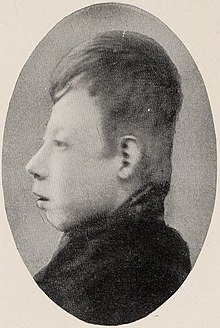Turricephaly: Difference between revisions
Content deleted Content added
standard terminology; clarify oxycephaly and acrocephaly as forms of turricephaly with a conical head shape |
+citation https://pubmed.ncbi.nlm.nih.gov/19125436/ |
||
| Line 23: | Line 23: | ||
}} |
}} |
||
[[File:Oxycephalic 2.jpg|alt=Profile view of patient|thumb|Young boy with oxycephaly, 1922]] |
[[File:Oxycephalic 2.jpg|alt=Profile view of patient|thumb|Young boy with oxycephaly, 1922]] |
||
'''Turricephaly''' is a type of [[cephalic disorder]] where the head appears tall with a small length and width.<ref>{{Cite web |title=Turricephaly |url=https://elementsofmorphology.nih.gov/index.cgi?tid=b1c6362251bad427 |access-date=2022-10-29 |website=Elements of Morphology |publisher=National Human Genome Research Institute}}</ref> It is due to premature closure of the [[coronal suture]] plus any other [[Suture (anatomy)|suture]], like the [[Lambdoid suture|lambdoid]],<ref name=TheFreeDictionary>{{cite web|title=oxycephaly|url=http://medical-dictionary.thefreedictionary.com/oxycephaly|publisher=TheFreeDictionary|access-date=24 August 2013}}</ref> or it may be used to describe the premature fusion of all sutures.<ref name="pmid15415226" /> It should be differentiated from [[Crouzon syndrome]]. Oxycephaly (or acrocephaly) is a form of turricephaly where the head is cone-shaped, and is the most severe of the [[Craniosynostosis|craniosynostoses]]. |
'''Turricephaly''' is a type of [[cephalic disorder]] where the head appears tall with a small length and width.<ref>{{Cite web |title=Turricephaly |url=https://elementsofmorphology.nih.gov/index.cgi?tid=b1c6362251bad427 |access-date=2022-10-29 |website=Elements of Morphology |publisher=National Human Genome Research Institute}}</ref><ref name=":0">{{Cite journal |last=Allanson |first=Judith E. |last2=Cunniff |first2=Christopher |last3=Hoyme |first3=H. Eugene |last4=McGaughran |first4=Julie |last5=Muenke |first5=Max |last6=Neri |first6=Giovanni |date=2009-01 |title=Elements of morphology: standard terminology for the head and face |url=https://pubmed.ncbi.nlm.nih.gov/19125436/ |journal=American Journal of Medical Genetics. Part A |volume=149A |issue=1 |pages=6–28 |doi=10.1002/ajmg.a.32612 |issn=1552-4833 |pmc=2778021 |pmid=19125436}}</ref> It is due to premature closure of the [[coronal suture]] plus any other [[Suture (anatomy)|suture]], like the [[Lambdoid suture|lambdoid]],<ref name=TheFreeDictionary>{{cite web|title=oxycephaly|url=http://medical-dictionary.thefreedictionary.com/oxycephaly|publisher=TheFreeDictionary|access-date=24 August 2013}}</ref> or it may be used to describe the premature fusion of all sutures.<ref name="pmid15415226" /> It should be differentiated from [[Crouzon syndrome]]. Oxycephaly (or acrocephaly) is a form of turricephaly where the head is cone-shaped, and is the most severe of the [[Craniosynostosis|craniosynostoses]].<ref name=":0" /> |
||
==Presentation== |
==Presentation== |
||
Revision as of 21:56, 29 October 2022
| Oxycephaly | |
|---|---|
| Other names | Oxycephaly,[1] Acrocephaly, Hypsicephaly,[1] Oxycephalia,[1] Steeple head,[1] Tower head,[1] Tower skull, High-head syndrome, Turmschädel,[2] |
 | |
| Specialty | Dysmorphology |
| Symptoms | reduced head length and width for age |

Turricephaly is a type of cephalic disorder where the head appears tall with a small length and width.[3][4] It is due to premature closure of the coronal suture plus any other suture, like the lambdoid,[5] or it may be used to describe the premature fusion of all sutures.[2] It should be differentiated from Crouzon syndrome. Oxycephaly (or acrocephaly) is a form of turricephaly where the head is cone-shaped, and is the most severe of the craniosynostoses.[4]
Presentation
Common associations
It may be associated with:[6]
Diagnosis
This section is empty. You can help by adding to it. (February 2018) |
Treatment
This section is empty. You can help by adding to it. (February 2018) |
See also
References
- ^ a b c d e Mosby's Medical Dictionary (8th ed.). Elsevier. 2009. Retrieved 24 August 2013.
- ^ a b Bodian, Martin (May 6, 1950). "Oxycephaly". Journal of the American Medical Association. 143 (1): 15–8. doi:10.1001/jama.1950.02910360017006. PMID 15415226.
- ^ "Turricephaly". Elements of Morphology. National Human Genome Research Institute. Retrieved 2022-10-29.
- ^ a b Allanson, Judith E.; Cunniff, Christopher; Hoyme, H. Eugene; McGaughran, Julie; Muenke, Max; Neri, Giovanni (2009-01). "Elements of morphology: standard terminology for the head and face". American Journal of Medical Genetics. Part A. 149A (1): 6–28. doi:10.1002/ajmg.a.32612. ISSN 1552-4833. PMC 2778021. PMID 19125436.
{{cite journal}}: Check date values in:|date=(help) - ^ "oxycephaly". TheFreeDictionary. Retrieved 24 August 2013.
- ^ Weerakkody, Yuranga; Goel, Ayush. "Oxycephaly". Radiopaedia.org. Retrieved 24 August 2013.
Further reading
Look up oxycephaly in Wiktionary, the free dictionary.
- NINDS Overview
- Ebenezer, Roy (1960). "Craniostenosis or oxycephaly". Indian Journal of Ophthalmology. 8 (3): 77–80. ISSN 0301-4738. PMID 13819157.
External links
